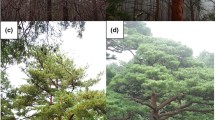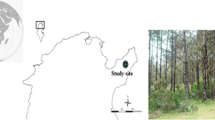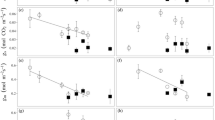Abstract
We used a null-balance porometer to measure leaf conductance of mature and primary leaves of natural seedlings, saplings, and trees ofPinus roxburghii (chir) during autumn at four sites at 1,320–1,930 m elevation in the central Himalaya of India. Our hypothesis that primary leaves had higher leaf conductance than mature leaves (needles in fascicles), based on measurements in other pines, was rejected. Comparisons on the same saplings and seedlings showed lower leaf conductance for primary leaves than for mature leaves. Primary leaves on seedlings and saplings also did not consistently have higher leaf conductance than mature leaves on near-by trees. Mature leaves on seedlings, however, did often have higher conductance than mature leaves on nearby trees. Mean values for leaf conductance (mmol m−2 s−1, based on total leaf surface area) ranged from 42–82 for mature leaves on trees, 60–121 for mature leaves on seedlings, and 28–67 for primary leaves on seedlings. Compared to published values for other pine species, conductance of mature leaves ofP. roxburghii is relatively low.
Similar content being viewed by others
Literature cited
Berrang, P.C. and Steiner, K.C. (1986) Seasonal changes in the cold tolerance of pitch pine. Can. J. For. Res. 16: 408–410.
Bormann, F.H. (1958) The relationships of ontogenetic development and environmental modification to photosynthesis inPinus taeda seedlings.In The physiology of forest trees. Thimann, K.V. (ed.), 678pp, Ronald Press, New York, 197–215.
Bormann, F.H. (1963) Ontogenetic relationships of the primary leaf ofPinus taeda L. andP. echinata Mill. Bull. Torrey Bot. Club 90: 320–332.
Dalton, C.T. and Messina, M.G. (1995) Water relations and growth of loblolly pine seedlings planted under a shelterwood and in a clear-cut. Tree Physiol. 15: 19–26.
Dhiman, R.C., Sharma, K.K., and Joshi, N.K. (1997) Conditioning induced morphological changes and their relationships with field planting survivals inPinus roxburghii Sarg. seedlings: Part 1-Growth parameters. Van Vigyan 35: 67–76. (cited in CAB Abstracts, number 980611226).
Doak, C.C. (1935) Evolution of foliar types, dwarf shoots, and cone scales ofPinus. Univ. Ill. Bull., Ill. Biol. Monogr. 13 (3).
Ellsworth, D.S. (1999) CO2 enrichment in a maturing pine forest: Are CO2 exchange and water status in the canopy affected? Plant Cell Environ. 22: 461–472.
Grubb, P.J. (1977) The maintenance of species-richness in plant communities: The importance of the regeneration niche. Biol. Rev. 52: 107–145.
Hari, P., Makela, A., Berninger, F., and Pohja, T. (1999) Field evidence for the optimality hypothesis of gas exchange in plants. Aust. J. Plant Physiol. 26: 239–244.
Jackson, J.K. (1994) Manual of afforestation in Nepal. Second edition. Volume 2. 824pp, Ministry of Forests and Soil Conservation, Kathmandu, Nepal.
Johnson, J.D. (1984) A rapid technique for estimating total surface area of pine leaves. Forest Sci. 30: 913–921.
Klaus, W. (1989) Mediterranean pines and their history. Plant Syst. Evol. 162: 133–163.
Knauf, T.A. and Bilan, M.V. (1977) Cotyledon and primary needle variation in loblolly pine from mesic and xeric seed sources. Forest Sci. 23: 33–36.
Konar, R.N. (1963) Anatomical studies of Indian pines with special reference toPinus roxburghii Sar. Phytomorphology 13: 388–402.
Korner, C., Scheel, J.A., and Bauer, H. (1979) Maximum leaf diffusive conductance in vascular plants. Photosynthetica 13: 45–82.
Koskela, J., Hari, P., and Pipatwattanakul, D. (1999) Analysis of gas exchange of Merkus pine populations by the optimality approach. Tree Physiol. 19: 511–518.
Kozlowski, T.T., Kramer, P.J., and Pallardy, S.G. (1991) The physiological ecology of woody plants. 657pp, Academic Press, San Diego.
Lester, D.T. (1968) Developmental patterns of axillary meristematic activity in seedlings ofPinus. Bot. Gaz. 129: 206–210.
Miller, P.M., Eddleman, L.E., and Miller, J.M. (1995)Juniperus occidentalis juvenile foliage: Advantages and disadvantages for a stress tolerant, invasive conifer. Can. J. For. Res. 25: 470–479.
Mirov, N.T. (1967) The genusPinus. 602pp, Ronald Press, New York.
Morales, D., Peters, J., Soledad Jimenez, M., Tausz, M., Wonisch, A., and Grill, D. (1999) Gas exchange of irrigated and non-irrigatedPinus canariensis seedlings growing outdoors in La Laguna, Canary Islands, Spain. Z. Naturforsch. C. Biosci. 54: 693–697.
Murthy, R., Zarnoch, S.J., and Dougherty, P.M. (1997) Seasonal trends of light-saturated net photosynthesis and stomatal conductance of loblolly pine trees grown in contrasting environments of nutrition, water and carbon dioxide. Plant Cell Environ. 20: 558–568.
Pearcy, R.W., Schulze, E.-D., and Zimmermann, R. (1989) Measurement of transpiration and leaf conductance.In Plant physiological ecology: Field methods and instrumentation. Pearcy, R.W., Ehleringer, J., Mooney, H.A., and Rundel, P.W. (eds.), 457pp, Chapman and Hall, London, 137–160.
Pena, J. and Grace, J. (1986) Water relations and ultrasound emissions ofPinus sylvestris L. before, during and after a period of water stress. New Phytol. 103: 515–524.
Peterson, J.A., Seiler, J.R., Nowak, J., Ginn, S.E., and Kreh, R.E. (1997) Growth and physiological responses of young loblolly pine stands to thinning. Forest Sci. 43: 529–534.
Price, R.A., Liston, A., and Strauss, S.H. (1998) Phylogeny and systematics ofPinus.In Ecology and biogeography ofPinus. Richardson, D.M. (ed), 527pp, Cambridge University Press, Cambridge, 49–68.
Rao, P.B. and Singh, S.P. (1985) Response breadths on environmental gradients of germination and seedling growth in two dominant forest tree species of central Himalaya. Ann. Bot. 56: 783–794.
Richardson, D.M. and Rundel, P.W. (1998) Ecology and biogeography ofPinus: An introduction.In Ecology and biogeography ofPinus. Richardson, D.M. (ed.), 527pp, Cambridge University Press, Cambridge, 3–46.
Singh, J.S. and Singh, S.P. (1992) Forests of Himalaya: Structure, functioning and impact of man. 295pp, Gyanodaya Prakashan, Naini Tal.
Smith, W.K. (1985) Western montane forests.In Physiological ecology of North American plant communities. Chabot, B.F. and Mooney, H.A. (eds.), 351pp, Chapman and Hall, New York, 95–126.
Stone, E.L., Jr. and Stone, M.H. (1954) Root collar sprouts in pine. J. For. 52: 487–491.
Tewari, D.N. (1994) A monograph on Chir pine (Pinus roxburghii Sarg.). 311pp, International Book Distributors, Dehra Dun.
Thadani, R. (1999) Disturbance, microclimate and the competitive dynamics of tree seedlings in banj oak (Quercus leucotrichophora) forests of the central Himalaya, India. 318pp, Ph.D. dissertation, Yale University, New Haven CT.
Thompson, S. (1976) Some observations on the shoot growth of pine seedlings. Can. J. For. Res. 6: 341–347.
Troup, R.S. (1921) The silviculture of Indian trees. Vol. 3. Lauraceae to Coniferae. 1195pp, Clarendon Press, Oxford.
Turunen, M.T., Vogelmann, T.C., and Smith, W.K. (1999). UV screening in lodgepole pine (Pinus contorta spp.latifolia) cotyledons and leaves. Int. J. Plant Sci. 160: 315–320.
Van Buijtenen, J.P., Bilan, M.V., and Zimmerman, R.H. (1976) Morphophysiological characteristics related to drought resistance inPinus taeda.In Tree physiology and yield improvement. Cannell, M.G.R. and Last, F.T. (eds.), 567pp, Academic Press, London, 349–359.
Wakamiya, N.I., Heilman, J.L., Newton, R.J., and Messina, M.G. (1999) Diurnal changes in water conduction in loblolly pine (Pinus taeda) and Virginia pine (P. virginiana) during soil dehydration. Tree Physiol. 19: 575–581.
Wang, K.Y. and Kellomaki, S. (1997) Stomatal conductance and transpiration in shoots of Scots pine after 4-year exposure to elevated CO2 and temperature. Can. J. Bot. 75: 552–561.
Weber, J.A., Clark, C.S., and Hogsett, W.E. (1993) Analysis of the relationships among O3 uptake, conductance, and photosynthesis in leaves ofPinus ponderosa. Tree Physiol. 13: 157–172.
Wright, R.D. (1970) CO2 exchange of seedling pines in the laboratory as related to lower elevational limits. Am. Mid. Nat. 83: 291–300.
Zhang, S.S., Hennessey, T.C., and Heinemann, R.A. (1997) Acclimation of loblolly pine (Pinus taeda) foliage to light intensity as related to leaf nitrogen availability. Can. J. For. Res. 27: 1032–1040.
Zobel, D.B. (1969) Factors affecting the distribution ofPinus pungens, an Appalachian endemic. Ecol. Monogr. 39: 303–333.
Author information
Authors and Affiliations
Additional information
Funding for this study was provided by grants from the United States National Science Foundation, INT-9312052 and INT-9404043. We appreciate the review of an early draft by Barbara Bond.
About this article
Cite this article
Zobel, D.B., Garkoti, S.C. & Singh, S.P. Leaf conductance of primary and mature leaves ofPinus roxburghii: A comparison. J For Res 6, 1–5 (2001). https://doi.org/10.1007/BF02762715
Accepted:
Issue Date:
DOI: https://doi.org/10.1007/BF02762715




